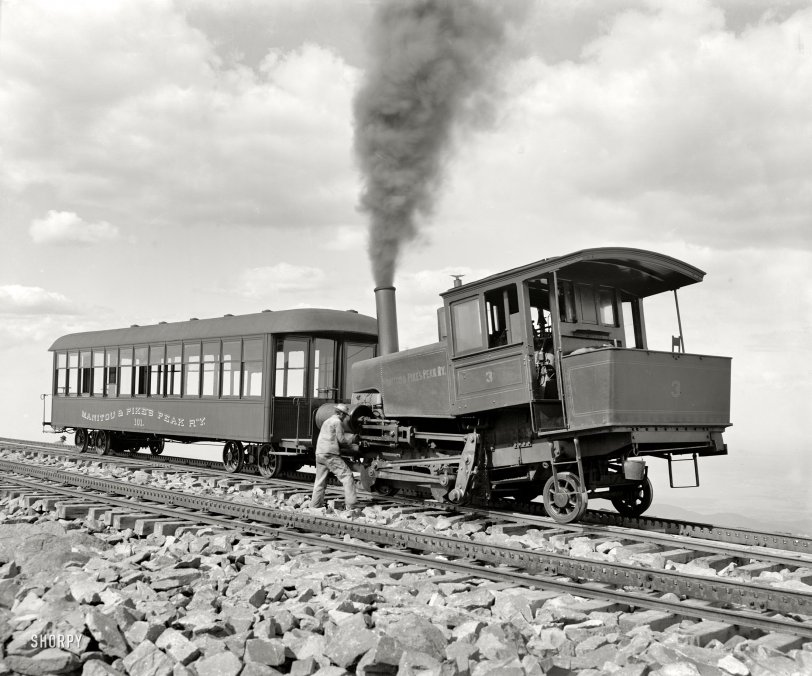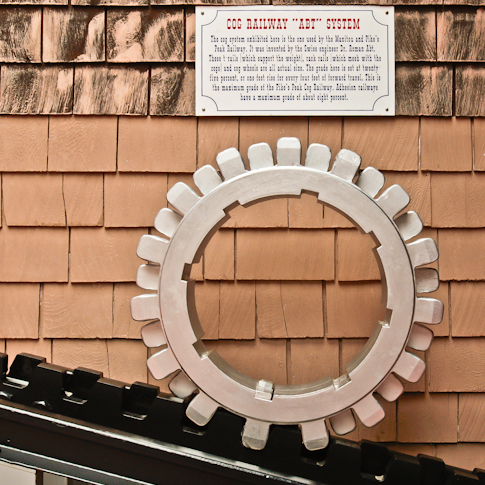


Framed or unframed, desk size to sofa size, printed by us in Arizona and Alabama since 2007. Explore now.
Shorpy is funded by you. Patreon contributors get an ad-free experience.
Learn more.

- Texas Flyer wanted
- Just a Year Too Soon
- WWII -- Replacing men with women at the railroad crossing.
- Yes, Icing
- You kids drive me nuts!
- NOT An Easy Job
- I wonder
- Just add window boxes
- Icing Platform?
- Indiana Harbor Belt abides
- Freezing haze
- Corrections (for those who care)
- C&NW at Nelson
- Fallen Flags
- A dangerous job made worse
- Water Stop
- Passenger trains have right of way over freights?
- Coal
- Never ceases to amaze me.
- Still chuggin' (in model form)
- Great shot
- Westerly Breeze
- For the men, a trapeze
- Tickled
- Sense of loneliness ...
- 2 cents
- Charm City
- What an Outrage
- Brighton Park
- Catenary Supports
Print Emporium
Colorado Choo-Choo: 1900

Pikes Peak, Colorado, circa 1900. "Summit, cog wheel train, Manitou and Pike's Peak Railway." 8x10 glass negative by William Henry Jackson. View full size.
Synchronicity
What a coincidence! We just rode the Pikes Peak Cog Railway three days ago with children and grandchildren. It still takes about three hours, and it is an amazing ride. Temps were about 90 degrees in Manitou Springs and below 50 degrees at the summit. We even had a little skiff of snow up top. We passed by the original water cranes that supplied the early steam engines. The trip is spectacular, but I kind of wish I could have taken it in the steam days. (Of course, I would be dead by now, right?) It was great to get back to internet civilization and find this picture on Shorpy!
Cog and Pinion Appliances
Crofutt's Overland Guide, 1892.The Manitou & Pike's Peak Railway, a recent organization, commences at a point just above the Iron Springs and runs to the summit of Pike's Peak. The road is about 8¾ miles in length. The average grade is 18 per cent.,the maximum being 25 per cent. and the minimum 8 per cent., with 16 degrees curvature. The rails are the standard T rail, with a double cog-rail in the center, weighing 110 tons to the mile. Each engine has three cog and pinion appliances, which can be worked together or independently; in each cog appliance is a double set of pinion brakes that work in the cog, either of which when used can stop the engine in 12 inches going either way, on any grade and at a maximum speed of eight miles an hour. Fare for "round trip," $5.00.
The Street Railway Journal, April, 1893.Manitou & Pike's Peak Railroad,
which is known as the "Cog Wheel Railroad," and which runs to the top of Pike's Peak, a distance of about about 8,000 ft. higher than Manitou. The road was opened for traffic in October, 1890. The fare for the round trip is $5, and the round trip is made in about three hours. The rack, which is placed midway between the rails, consists of two steel bars, notched to a depth of about two and a half inches, with teeth staggered, and which are firmly fastened to the ties by means of bolts and shouldered chairs.
The engines are of peculiar shape, and the power is transmitted to two pinions located under the boiler, which mesh with the gear of the rack, so that sufficient power is obtained to force the engine and car up the steepest grades. Only one car trains are run, and the cars are pushed ahead of the engines in ascending, and return in the same relation. The engine and car are not coupled, but there are bumpers consisting of perpendicular and horizontal steel cylinders about five inches in diameter and eighteen inches long, which provide for the varying grades and angles. The car, as well as the engine, is equipped with pinions which mesh into the rack and which are controlled by powerful band brakes, so that the car can be controlled independent of the engine, every known safety appliance being employed to prevent the possibility of an accident.
Formerly, high pressure engines were employed, but during the last season one compound engine was run, and the other three engines have recently been sent to the Baldwin Locomotive Works where they are being made over into compounds. The line is operated only during the summer months, as the accumulation of snow upon the mountains during the winter prevents the running of the cars.
Journal of the Association of Engineering Societies, 1894.Manitou and Pike's Peak Railway.
The Engines
During construction and the first year's operation, the Pike's Peak Railway had three engines built by the Baldwin Locomotive Works. These weighed about 26 tons each, loaded with fuel and water. The cabs and boilers of these engines were much like those of ordinary locomotives, but here the resemblance ceased, for the bearing-frame of the engine was inclined, so that the boiler was level on a 16 per cent. grade, the average grade of the road. The engine had no tender, water being carried in two tanks at the side of the boiler, and coal in a box at the rear of the cab, holding one ton. The engine rested on three axles, the forward two being rigidly fastened to the frame, while the rear one was furnished with a radius bar, the rigid wheel-base being 6 feet 8 inches, and the total wheel-base 11 feet 2 inches. To the two forward axles was fastened an inside frame carrying three sets of two pinions each, making six pinions in all. The specifications for these pinions called for hammered crucible steel, with ultimate tensile strength of 100,000 pounds per square inch, stretch 16 per cent, in 8 inches, the teeth to be cutout of the solid disk.
Oh My. Call a Tow Truck, er Train
"But officer, just look -- that passenger car was heading the wrong way on my side of the tracks. Now how am I ever gonna get the front end of my engine out from under it??"
Nice Trip!
Today a ticket on the Railway costs $34. You can hike up and take the train down, but if you miss the last train and have to be evacuated, the fee per hiker is $500!
I'd stick with the train. Looks lovely.
Dinosaurs in the mountains
The sister to this locomotive, M&PP #4, is still nominally operable and is as far as anyone knows the only operable Vauclain compound. The two cylinders you see are both power cylinders; the valves are hidden on the inside. Vauclain compounds, named after the head of Baldwin, were briefly popular around 1900 but fell out of favor along with most other compound locos with the introduction of the superheater; in this case part of the problem was unequal forces from the two pistons which produced wear problems at the crosshead. On this little bitty engine it apparently wasn't too bad a problem.

























On Shorpy:
Today’s Top 5